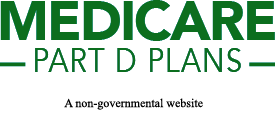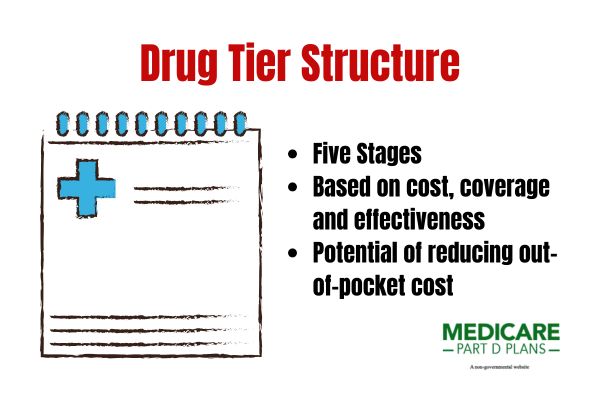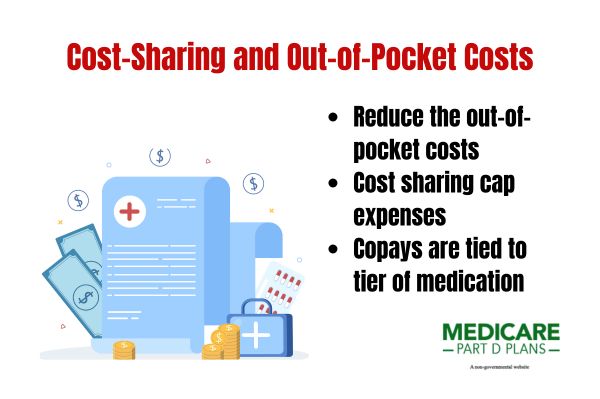Find a Medicare Part D prescription drug plan

Medicare Part D
Prescription Drug Coverage 2026
Formulary and Drug Tiers in Medicare Part D (2026 Update)
The Medicare Part D Update
Learn about the various tier structures, the selected drug subsidy program, and potential updates to protected drug classes. This article will help you understand these possible changes and their potential impact on your prescription costs.
Key Takeaways
In 2026 , Medicare Part D may introduce various changes, such as a selected drug subsidy program that may reduce some out-of-pocket costs and coverage for certain chronic condition medications.
- The updated tier structure will likely categorize medications into five tiers to help manage drug costs, with specific cost-sharing details based on the tier level.
- Beneficiaries should review their Medicare Part D plans annually to ensure they are meeting their healthcare needs and avoiding unnecessary expenses due to changes in coverage.
Formulary and Drug Tiers in Medicare Part D 2026 Update
This initiative will likely seek to lower out-of-pocket costs for beneficiaries, possibly making essential medications more affordable.
Part D plans may also cover selected drugs with a maximum fair price, possibly ensuring vital medications for chronic conditions may be accessible to all. Additionally, Medicare Part D formularies will keep listing covered drugs, likely offering ongoing access to essential treatments.
Some Part D plans may be required to cover specific classes of protected drugs. These potential updates will likely demonstrate a continued commitment to comprehensive Part D prescription drug coverage and potentially reduce high drug costs for beneficiaries.
Introduction
Medicare Part D will likely be an optional program that could aid in covering certain prescription medication costs for Medicare enrollees. Unlike other parts of Medicare, the Medicare Part D program is provided through private insurance plans that are approved by Medicare.
These plans will likely aim to manage prescription drug expenses, which could be particularly burdensome for seniors and those with chronic illnesses.
Knowing the structure of Medicare Part D, from the initial coverage phase to the catastrophic phase, could help beneficiaries maximize their benefits. This article will explain these phases and offer practical advice for navigating the complexities of your prescription drug plan.
Overview of Medicare Part D Formularies
Medicare Part D is a voluntary benefit that could assist with covering some prescription drug costs. These costs may vary widely, so understanding your plan’s formulary—a list of covered medications—is crucial.
The formulary could potentially ensure beneficiaries could get access necessary prescription drugs without prohibitive costs.
Part D plans should cover medications from six protected classes:
- Immunosuppressants
- Antidepressants
- Antipsychotics
- Anticonvulsants
- Antiretrovirals
- Antineoplastics
These classes might encompass medications critical for managing severe and chronic health conditions. Staying informed about your Medicare Part D coverage and such formulary changes is more important than ever.
Drug Tier Structure for 2026
The Medicare Part D drug tier structure will likely include five tiers, each representing different categories of medications that may vary in cost and coverage. This tiered approach may help manage drug costs by categorizing medications based on their price and clinical effectiveness.
Comprehending the tier structure might help beneficiaries make informed decisions about their prescription drug plans.
Each tier will likely have specific cost-sharing details, with generic drugs typically placed in the lower tiers, possibly leading to lower out-of-pocket costs, while specialty medications might fall into higher tiers, likely resulting in higher copayments or coinsurance.
Examples of Drugs in Each Tier
Tier 1 may include generic drugs, which will likely have lower co-payments, possibly making them affordable for many beneficiaries. In contrast, Tier 5 will likely feature high-cost specialty medications.
Knowing which tier your medications fall into could help anticipate out-of-pocket costs and plan your healthcare budget.
Prior Authorization and Step Therapy Rules
The new regulations will likely aim to streamline these processes, possibly making it easier for beneficiaries to get the medications they need in a timely manner.
The new rules may help clarify prior authorization criteria, possibly enhancing transparency and informing beneficiaries about their appeal rights in accordance with the final rule. This could be particularly important for those who may need to challenge a denial of coverage for a specific medication.
Cost-Sharing and Out-of-Pocket Costs
The annual out-of-pocket threshold for Medicare Part D will likely be around $2,100
If an enrollee incurs costs exceeding the threshold, the structure of cost-sharing, from the initial coverage phase to the catastrophic phase, will likely play a crucial role in managing these expenses.
In the initial coverage phase, medications in Tier 1 typically include generic drugs that may have lower co-payments, possibly making them affordable for most beneficiaries. As you move up the tiers, co-payments and coinsurance amounts might increase, as Tier 4 medications might require higher out-of-pocket costs.
For those who reach the catastrophic coverage phase, the potential reduction for out-of-pocket spending may be substantial. Planning and understanding these cost-sharing structures could help you manage your healthcare expenses more effectively, possibly leading to cost savings.
Potential Impacts of Inflation Reduction Act on Part D
The Inflation Reduction Act will likely bring several changes to Medicare Part D, likely aimed at reducing prescription drug spending and potentially capping out-of-pocket costs for beneficiaries.
One of the possible changes might be the elimination of the coverage gap, also known as the ‘donut hole,’ starting January 1, 2025. This change could potentially simplify the cost-sharing structure and may provide more predictable expenses for beneficiaries.
These potential updates, along with a possible decrease in the average monthly premium for Part D plans, will likely reflect the ongoing efforts to make prescription medications more affordable and accessible for Medicare beneficiaries through a Medicare prescription payment plan.
Specialty Medications and High Drug Costs
Specialty medications, likely categorized under Tier 5, may come with higher cost-sharing requirements. These medications could be essential for managing complex health conditions but may also lead to higher out-of-pocket costs for beneficiaries.
The coinsurance for specialty drugs could potentially range up to 33%, likely making it crucial for beneficiaries to plan their healthcare expenses carefully. Understanding which medications fall into this category and exploring potential cost-saving measures, such as the selected drug subsidy program, could help manage these costs.
For those dealing with high drug costs, exploring generic alternatives or discussing cost-saving strategies with healthcare providers is advisable. Staying informed about your Medicare Part D coverage and the available assistance programs could make a substantial difference in managing your out-of-pocket expenses.
See plans in your area instantly!
Advertisement
Manufacturer Discount Program
The Manufacturer Discount Program, which replaced the Coverage Gap Discount Program, will likely require pharmaceutical companies to offer discounts on qualifying medications during the Initial and Catastrophic phases of Medicare Part D.
This program could potentially reduce out-of-pocket expenses for beneficiaries by possibly offering to cover a portion of drug costs.
During the Initial Coverage Phase, participating manufacturers may provide up to 10% discount on eligible drugs. In the Catastrophic Coverage Phase, the discount may increase to about 20%, possibly alleviating the financial burden on beneficiaries.
These potential discounts, combined with the coverage provided by Part D plans, could help ensure that essential medications remain accessible and affordable.
Annual Review of Medicare Part D Plans
Potential changes in Medicare plan coverage may occur each year, making it essential for beneficiaries to evaluate their plans annually.
Reviewing your Medicare Part D plan each year, especially in September and October before the Annual Open Enrollment Period, can help you determine if your current plan still meets your health and financial needs.
Failing to review your plan may lead to costly errors, as beneficiaries may pay more for inadequate coverage. A simple 10 to 15-minute review could help you assess potential changes in premiums, drug coverage, and your plan’s monthly premium, likely ensuring that you are always getting the best value for your healthcare dollars.
Find a Plan and Enroll Online Yourself!
Advertisement
Summary
The potential updates to Medicare Part D
From drug tier structure to the possible impact of the Inflation Reduction Act, these changes will likely be designed to benefit Medicare beneficiaries by potentially reducing out-of-pocket costs and comprehensive drug coverage.
Staying informed about these various updates and reviewing your Medicare Part D plan annually may help you navigate the complexities of prescription drug coverage.
By taking proactive steps and understanding your options, you can make the most of your Medicare benefits and help ensure that you receive the necessary medications without undue financial burden.
Frequently Asked Questions
What are the potential changes to Medicare Part D in 2026 ?
Medicare Part D
How might the new selected drug subsidy program work?
The new selected drug subsidy program will likely work by offering a government subsidy of about 10% on the negotiated price of selected drugs, possibly lowering out-of-pocket expenses for beneficiaries.
This initiative could potentially make essential medications more affordable.
What should I do if my medication is not covered by my plan’s formulary?
If your medication is not covered by your plan’s formulary, you should file an appeal, seek a temporary supply, and discuss alternative options with your healthcare provider.
What are the possible benefits of the Manufacturer Discount Program?
The Manufacturer Discount Program could potentially provide savings on qualifying medications during both the Initial and Catastrophic phases, possibly lowering out-of-pocket costs for beneficiaries. This potential financial relief could be crucial for managing healthcare expenses.
Why is it important to review my Medicare Part D plan annually?
It is important to review your Medicare Part D plan annually to ensure it continues to meet your health and financial needs, while also identifying any changes in premiums and drug coverage that could impact your costs. Regular reviews may help prevent costly errors and ensure you maximize your benefits.
Begin Choosing your plan
Advertisement
ZRN Health & Financial Services, LLC, a Texas limited liability company.



